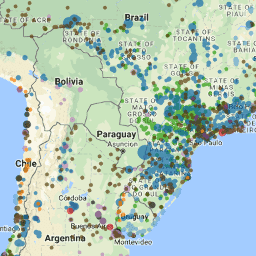
- Dostępność zbioru danych
- 2018-06-11T00:00:00Z–2018-06-11T00:00:00Z
- Dostawca zbioru danych
- World Resources Institute
- Tagi
Opis
Global Power Plant Database to kompleksowa baza danych typu open source zawierająca informacje o elektrowniach na całym świecie. Centralizuje dane elektrowni, aby ułatwić nawigację, porównywanie i wyciąganie wniosków. Każda elektrownia jest geolokalizowana, a wpisy zawierają informacje o jej mocy, produkcji, własności i rodzaju paliwa. Od czerwca 2018 r. baza danych zawiera około 28 500 elektrowni ze 164 krajów. Będzie ona na bieżąco aktualizowana w miarę pojawiania się danych.
Metodologia tworzenia zbioru danych jest opisana w publikacji World Resources Institute „A Global Database of Power Plants” (Globalna baza danych elektrowni).
Powiązany kod do tworzenia zbioru danych znajdziesz na stronie GitHub. Najnowsza wersja bazy danych (która może znacznie różnić się od wersji w Earth Engine) jest również dostępna na GitHubie.
Jeśli korzystasz z tego zbioru danych, dostawca (WRI) prosi o zarejestrowanie sposobu jego wykorzystania i (opcjonalnie) o zarejestrowanie się w celu otrzymywania powiadomień o aktualizacjach.
Schemat tabeli
Schemat tabeli
| Nazwa | Typ | Opis |
|---|---|---|
| kraj | CIĄG ZNAKÓW | 3-znakowy kod kraju zgodny ze specyfikacją ISO 3166-1 alpha-3. |
| country_lg | CIĄG ZNAKÓW | Dłuższa forma oznaczenia kraju |
| nazwa | CIĄG ZNAKÓW | Nazwa lub tytuł elektrowni, zwykle w formie zromanizowanej |
| gppd_idnr | CIĄG ZNAKÓW | 10- lub 12-znakowy identyfikator elektrowni. |
| capacitymw | LICZBA ZMIENNOPRZECINKOWA O PODWÓJNEJ PRECYZJI | Moc wytwarzania energii elektrycznej w megawatach |
| latitude | LICZBA ZMIENNOPRZECINKOWA O PODWÓJNEJ PRECYZJI | Geolokalizacja w stopniach dziesiętnych |
| longitude | LICZBA ZMIENNOPRZECINKOWA O PODWÓJNEJ PRECYZJI | Geolokalizacja w stopniach dziesiętnych |
| fuel1 | CIĄG ZNAKÓW | Źródło energii wykorzystywane do wytwarzania lub eksportowania energii elektrycznej |
| fuel2 | CIĄG ZNAKÓW | Źródło energii wykorzystywane do wytwarzania lub eksportowania energii elektrycznej |
| fuel3 | CIĄG ZNAKÓW | Źródło energii wykorzystywane do wytwarzania lub eksportowania energii elektrycznej |
| fuel4 | CIĄG ZNAKÓW | Źródło energii wykorzystywane do wytwarzania lub eksportowania energii elektrycznej |
| comm_year | CIĄG ZNAKÓW | Rok rozpoczęcia eksploatacji elektrowni, ważony przez moc jednostki, jeśli dane są dostępne |
| właściciel | CIĄG ZNAKÓW | Większościowy udziałowiec elektrowni, zwykle w formie zromanizowanej |
| źródło | CIĄG ZNAKÓW | Podmiot raportujący dane, może to być organizacja, raport lub dokument, zwykle w formie zromanizowanej. |
| URL | CIĄG ZNAKÓW | Dokument internetowy odpowiadający polu „source” |
| src_latlon | CIĄG ZNAKÓW | Atrybucja informacji geolokalizacyjnych |
| cap_year | LICZBA ZMIENNOPRZECINKOWA O PODWÓJNEJ PRECYZJI | Rok, w którym zgłoszono informacje o pojemności |
| gwh_2013 | LICZBA ZMIENNOPRZECINKOWA O PODWÓJNEJ PRECYZJI | Produkcja energii elektrycznej w gigawatogodzinach w 2013 roku |
| gwh_2014 | LICZBA ZMIENNOPRZECINKOWA O PODWÓJNEJ PRECYZJI | Produkcja energii elektrycznej w gigawatogodzinach w 2014 roku |
| gwh_2015 | LICZBA ZMIENNOPRZECINKOWA O PODWÓJNEJ PRECYZJI | Produkcja energii elektrycznej w gigawatogodzinach w 2015 roku |
| gwh_2016 | LICZBA ZMIENNOPRZECINKOWA O PODWÓJNEJ PRECYZJI | Produkcja energii elektrycznej w gigawatogodzinach w 2016 r. |
| gwh_estimt | LICZBA ZMIENNOPRZECINKOWA O PODWÓJNEJ PRECYZJI | Szacowana roczna produkcja energii elektrycznej w gigawatogodzinach w 2015 r. |
Warunki korzystania z usługi
Warunki korzystania z usługi
Cytaty
Global Energy Observatory, Google, KTH Royal Institute of Technology w Sztokholmie, University of Groningen, World Resources Institute. 2018 r. Globalna baza danych elektrowni. Opublikowane w Resource Watch i Google Earth Engine:https://resourcewatch.org/ https://earthengine.google.com/
Odkrywanie za pomocą Earth Engine
Edytor kodu (JavaScript)
// Visualization for WRI/GPPD/power_plants var table = ee.FeatureCollection('WRI/GPPD/power_plants'); // Get a color from a fuel var fuelColor = ee.Dictionary({ 'Coal': '000000', 'Oil': '593704', 'Gas': 'bc80bd', 'Hydro': '0565A6', 'Nuclear': 'e31a1c', 'Solar': 'ff7f00', 'Waste': '6a3d9a', 'Wind': '5ca2d1', 'Geothermal': 'fdbf6f', 'Biomass': '229a00' }); // List of fuels to add to the map var fuels = [ 'Coal', 'Oil', 'Gas', 'Hydro', 'Nuclear', 'Solar', 'Waste', 'Wind', 'Geothermal', 'Biomass']; /** * Computes size from capacity and color from fuel type. * * @param {!ee.Geometry.Point} pt A point * @return {!ee.Geometry.Point} Input point with added style dictionary. */ function addStyle(pt) { var size = ee.Number(pt.get('capacitymw')).sqrt().divide(10).add(2); var color = fuelColor.get(pt.get('fuel1')); return pt.set( 'styleProperty', ee.Dictionary({'pointSize': size, 'color': color})); } // Make a FeatureCollection out of the power plant data table. var pp = ee.FeatureCollection(table).map(addStyle); print(pp.first()); /** * Adds power plants of a certain fuel type to the map. * * @param {string} fuel A fuel type */ function addLayer(fuel) { print(fuel); Map.addLayer( pp.filter(ee.Filter.eq('fuel1', fuel)) .style({styleProperty: 'styleProperty', neighborhood: 50}), {}, fuel, true, 0.65); } // Apply `addLayer` to each record in `fuels`. fuelColor.keys().evaluate(function(fuelsList) { fuelsList.map(addLayer); });
Wyświetlanie jako widok cech
FeatureView to przyspieszona reprezentacja FeatureCollection, którą można tylko wyświetlać. Więcej informacji znajdziesz w
FeatureView dokumentacji.
Edytor kodu (JavaScript)
var fvLayer = ui.Map.FeatureViewLayer('WRI/GPPD/power_plants_FeatureView'); var visParams = { opacity: 0.65, color: { property: 'fuel1', categories: [ ['Coal', '000000'], ['Oil', '593704'], ['Gas', 'bc80bd'], ['Hydro', '0565a6'], ['Nuclear', 'e31a1c'], ['Solar', 'ff7f00'], ['Waste', '6a3d9a'], ['Wind', '5ca2d1'], ['Geothermal', 'fdbf6f'], ['Biomass', '229a00'] ], defaultValue: 'ffffff' }, rules: [ { filter: ee.Filter.expression('capacitymw < 500'), pointSize: 5, }, { filter: ee.Filter.expression('capacitymw >= 500 AND capacitymw < 1000'), pointSize: 10, }, { filter: ee.Filter.expression('capacitymw >= 1000'), pointSize: 15, } ] }; fvLayer.setVisParams(visParams); fvLayer.setName('Power plant (fuel type and capacity)'); Map.setCenter(16, 49, 4); Map.add(fvLayer);
